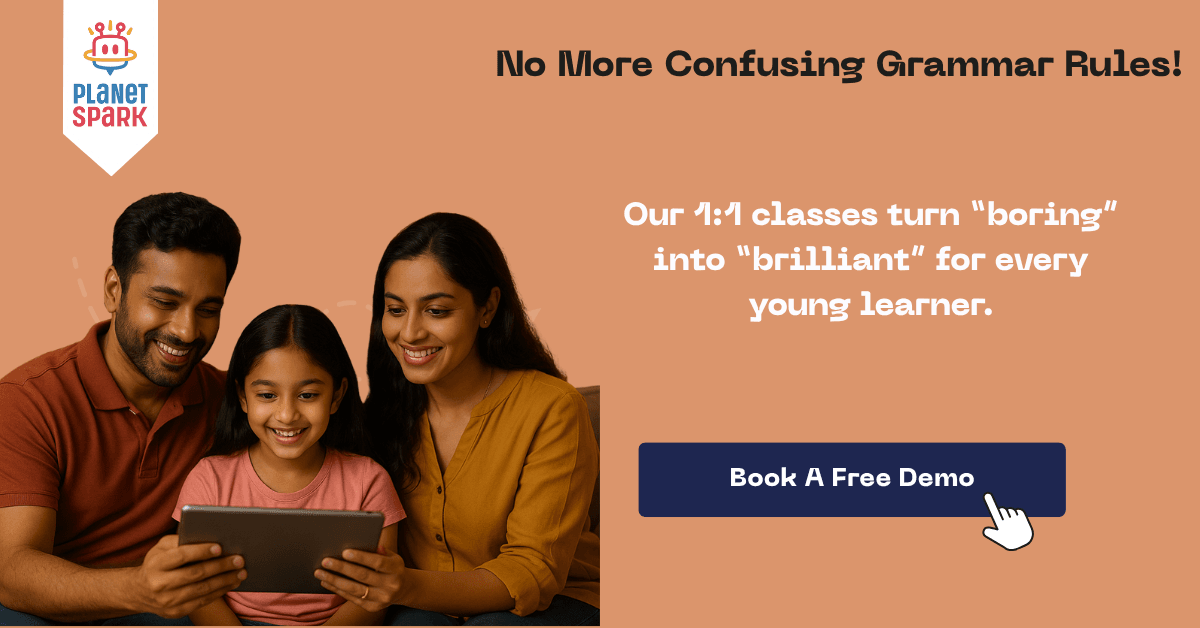Pronouns for Class 4 – Types, Examples & Exercises

What Is a Pronoun?
A pronoun is a word used in place of a noun. Instead of repeating the name of a person, place, or thing, we use words like he, she, it, they, and this to make our sentences easier to read and understand. Pronouns are one of the most important grammar topics your child will learn in Class 4, as they form the building blocks for writing fluently and speaking correctly.
In this blog, we’ll explain pronouns in simple terms for Class 4 students, explore different types of pronouns, provide sentence examples, and include easy exercises to reinforce learning.
Why Do We Use Pronouns?
Imagine you’re writing a story about Ria. Without pronouns, your sentences might sound like this:
“Ria is a smart girl. Ria studies hard. Ria plays tennis. Ria likes music.”
It feels repetitive, right?
Now, let’s use pronouns:
“Ria is a smart girl. She studies hard. She plays tennis. She likes music.”
Now it sounds better. That’s what pronouns do, they help us say more while repeating less.

Types of Pronouns for Class 4
In Class 4, children are introduced to various types of pronouns. Learning these types helps them understand when and where to use each kind of pronoun correctly.
Here are the main types of pronouns Class 4 students should know:
| Type | Definition | Examples |
|---|---|---|
| Personal Pronouns | Replaces a person or thing in a sentence | I, you, he, she, it, we, they |
| Demonstrative Pronouns | Points out specific things or people | this, that, these, those |
| Reflexive Pronouns | Refers back to the subject of the sentence | myself, yourself, himself, herself |
| Possessive Pronouns | Shows ownership or belonging | mine, yours, his, hers, ours, theirs |
| Interrogative Pronouns | Used to ask questions | who, whom, which, what, whose |
1. Personal Pronouns
These are the most common pronouns. They stand in for people or things already known in the conversation.
Examples:
I am reading a book.
He is my brother.
They are going to the market.
Tip for kids: Use personal pronouns to keep your sentences short and smooth.
2. Demonstrative Pronouns
These pronouns point to specific things or people.
Examples:
This is my pencil. (near)
That is your bag. (far)
These are new shoes.
Those are old toys.
Tip: This and These are used for things that are close. That and Those are for things that are far.
3. Reflexive Pronouns
These pronouns refer back to the subject of the sentence. They end in -self or -selves.
Examples:
I made this card myself.
She taught herself how to paint.
We enjoyed ourselves at the picnic.
Tip: Use these when the subject and the object of the sentence are the same person.
4. Possessive Pronouns
They show who owns something.
Examples:
This pen is mine.
That notebook is yours.
The toys are theirs.
Tip: These do not need apostrophes. “Yours” is correct, not “your’s.”
5. Interrogative Pronouns
These are used to ask questions.
Examples:
Who is knocking at the door?
Which dress do you like?
What is your name?
Whose pencil is this?
Tip: These are used at the beginning of questions and help gather more information.
Pronoun Examples in Sentences
Understanding how pronouns fit into real sentences is key. Here are some examples grouped by type:
Personal: She is my sister. He is reading a book.
Demonstrative: This is your bottle. Those are my shoes.
Reflexive: He cooked the dinner himself. I made this cake myself.
Possessive: That mobile is mine. The school bag is hers.
Interrogative: Who is your best friend? What do you want to eat?
Encourage children to write their own sentences using each type. It helps in retention and fluency.
Pronoun Exercises for Class 4
Now, let’s test your understanding with a few fun and simple exercises.
Exercise 1: Fill in the blanks with the correct pronoun
This is Rohan. ___ is my friend.
My friends and I are in the same class. ___ study together.
My cat is hungry. Let ___ eat.
She completed the project by ___.
___ is calling me from the gate?
Answer Key:
He
We
It
Herself
Who
Exercise 2: Identify the type of pronoun used
This is my pencil.
He is a football player.
We did the work ourselves.
That bag is mine.
What is your favourite colour?
Answers:
Demonstrative
Personal
Reflexive
Possessive
Interrogative
Why Should Class 4 Students Learn Pronouns?
Pronouns are more than just grammar rules. They help students:
Form well-structured, meaningful sentences
Avoid repeating nouns
Build stronger communication skills
Improve both writing and speaking
Lay the foundation for more advanced English grammar topics
Mastering pronouns early helps children feel more confident during exams, conversations, and creative writing assignments.

How PlanetSpark Makes Grammar Fun and Easy
PlanetSpark’s English and Grammar programs are designed to help children not just memorise grammar rules but actually use them in real communication.
Here’s what makes PlanetSpark different:
1:1 Grammar Coaching
Certified tutors help each child at their own pace with full personal attention.Gamified Practice Tools
Grammar becomes exciting with daily quizzes, Sparkie coins, and rewards.Creative Application
Children use grammar in real tasks like writing stories, speeches, and role-play.Live Feedback and Concept Correction
Students receive instant feedback and guidance to correct errors as they learn.Progress Reports and PTMs
Parents stay updated with regular tracking of grammar progress and growth.
Want your child to master pronouns and other grammar concepts with ease?
Book a FREE PlanetSpark class today and see the difference in just one session.
Related reads
Conjunctions for Class 4
Learn about conjunctions and how to join sentences smoothly.Noun for Class 4 Students
Before mastering pronouns, get clear on nouns with this guide.Verb for Class 4
Help your child learn how actions are described using verbs.Creative Writing for Class 4
Apply grammar in fun ways with these creative writing prompts.
Frequently Asked Questions
Q1. What is a pronoun in simple words?
A pronoun is a word used instead of a noun. It helps avoid repetition and makes sentences shorter and smoother.
Q2. How many types of pronouns are there for Class 4 students?
Typically, students in Class 4 are introduced to five main types: personal, demonstrative, reflexive, possessive, and interrogative pronouns.
Q3. Can my child practice pronouns online?
Yes. PlanetSpark offers interactive grammar games and worksheets as part of our English learning program.
Q4. What is the difference between “this” and “that”?
“This” refers to something near you, while “that” refers to something far from you.
Q5. How can I help my child understand pronouns better?
Use daily-life examples, read books together, ask them to spot pronouns in stories, and let them practice through quizzes and writing prompts.
Personalized Communication Report
Record a video to get a AI generated personalized communication report for your child

Hi There, want to try these
tips for your child with
LIVE with our expert coach?
Let's check your child's
English fluency
